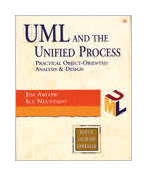Table Of
Contents:
Preface.
I.
INTRODUCTION TO UML AND USDP.
What is UML?
The birth of UML.
Why 'unified'?
Objects and the UML.
UML Structure.
UML building blocks.
UML common mechanisms.
Common divisions.
Extensibility mechanisms.
Architecture.
Summary.
Introduction to the Unified Software Development Process (USDP).
What is the Unified Software Development Process?
USDP axioms.
Instantiating USDP for your project.
Commercial USDP Variants.
USDP is an Iterative and Incremental Process.
Iteration Workflows.
Baselines and increments.
USDP Structure.
USDP Phases.
Inception.
Elaboration.
Construction.
Transition.
Summary.
II.
Requirements Workflow.
Introduction.
Software Requirements - metamodel.
The importance of requirements.
What is a requirement?
Well formed requirements.
Functional & Non-functional Requirements.
The System Requirements Specification (SRS).
Requirements elicitation: The map is not the territory.
Summary.
Use case modelling.
Introduction.
USDP Workflow: Find actors and use cases.
Use case modelling.
The system boundary.
What are Actors?
Identifying Actors.
Time as an actor.
Use Cases.
Identifying use cases.
The use case diagram.
The project glossary.
USDP Activity: Detail a use case.
Use case specification.
Pre and postconditions.
Flow of events.
Branching within a flow.
Branching within a flow: If.
Branching: Alternative paths.
Repetition within a flow: For.
Repetition within a flow: While.
Requirements tracing.
Modelling complex use cases.
Complex use cases.
Scenarios.
When to use Use Case analysis.
Requirements-advanced use case modelling.
More relationships.
Actor generalisation.
Use case generalisation.
'include'.
'extend'.
Summary.
III.
Analysis.
Phases and
Workflows.
Analysis - Purpose.
Analysis model: rules of thumb.
Analysis Workflow Detail.
Classes and objects.
What are objects?
Encapsulation.
Messaging.
UML Object Notation.
Object attribute values.
Variants on object notation.
Object Notation: Key Points.
Classes.
Object and Class Notation.
Object instantiation.
Anatomy of a class.
Name compartment.
Attribute compartment.
Visibility.
Multiplicity.
Advanced attribute syntax.
Operation compartment.
Advanced operation syntax.
Class stereotype syntax.
Scope.
Instance scope.
Class scope.
Scope determines access.
Object construction.
BankAccount class example.
Summary.
Finding analysis classes.
Analyse a use case.
What are Analysis classes?
Anatomy of an Analysis class.
What makes a good analysis class? .
Analysis class rules of thumb.
Finding classes: noun/verb analysis.
Noun/verb analysis procedure.
Finding classes using CRC Cards.
CRC card procedure.
Other sources of classes.
Summary
Analysis - relationships.
What is a relationship?
Links.
Examples of links.
Alternate orthogonal style.
Link semantics - Summary.
Associations.
Association semantics.
Association syntax.
Multiplicity.
Multiplicity syntax.
Multiplicity example.
Reflexive associations.
Hierarchies and networks.
Multiplicity - Summary.
Navigability.
Navigability semantics.
Associations and attributes.
Association classes.
Qualified associations.
Summary.
Analysis - dependencies.
Dependencies.
'use' - the most common type of dependency.
Other types of dependency.
Abstraction dependencies.
Permission dependencies.
Usage dependencies.
Summary.
Analysis - inheritance and polymorphism.
Generalisation.
Class generalisation.
Class inheritance.
Overriding.
Abstract operations and classes.
Level of abstraction.
Polymorphism.
Polymorphism example.
Summary.
Analysis packages.
Package dependencies.
Transitivity.
Nested packages.
Package generalisation.
Package stereotypes.
Architectural analysis.
Finding analysis packages.
Cyclic package dependencies.
Summary.
Analysis-use case realisation.
Analyse a use case.
What are use case realisations?
UC realisation - elements.
Interaction diagrams.
Collaboration diagrams.
Multiobjects.
Iteration.
Branching.
Concurrency-active objects.
Other collaboration diagram features.
Sequence diagrams.
Self-delegation, branching and iteration.
Concurrency.
Object states and constraints.
Summary.
Analysis - activity diagrams.
What are activity diagrams?
Action states.
Subactivity states.
Transitions.
Branches.
Forks and joins.
Swimlanes.
Object flows.
Events and signals.
When to use activity diagrams.
Summary.
IV. Design.
Phases and
Workflows.
Purpose - Design.
Design model - metamodel.
Should we maintain 2 models?
Workflow - Design.
Artefacts - Design.
Artefact trace relationships.
Design classes.
Anatomy of a design class.
Well-formed design classes.
Multiple inheritance.
Summary.
Refining analysis relationships.
Aggregation and composition.
Aggregation.
Composition.
Composition and attributes.
Many to 1 and 1 to 1 relationships.
1 to many relationships.
Simple OCL collections.
The Map (not OCL).
When to use collections?
Reified relationships.
Summary.
Interfaces and subsystems.
Interfaces and component based development.
Finding interfaces.
Designing with interfaces.
Benefits of interfaces.
Design subsystems.
Subsystems and interfaces.
The Facade Pattern.
Physical architecture and layering.
Disadvantages of interfaces.
Summary.
Use case realisation - design.
Use case realisation - design.
Interaction diagrams - design.
Subsystem interactions.
Summary.
Design - basic statecharts.
Statechart diagrams.
Statecharts and classes.
Basic statechart syntax.
States.
State syntax.
Transition syntax.
Events.
Call events.
Signal events and signals.
Change events.
Time events.
Summary.
Advanced statecharts.
Sequential composite states.
Concurrent composite state.
Submachine communication.
Communication via attributes.
Submachine communication using sync states.
History.
Shallow history pseudo state.
Deep history pseudo state.
Submachine reference state.
Summary.
Design - deployment model.
Deployment model.
Summary.
V.
Implementation.
Introduction.
Phases and Workflows.
Purpose - Implementation.
Model trace relationships.
Implementation workflow.
Artefacts - Implementation.
The implementation model.
What is a component?
Interfaces.
Implementation subsystems.
The deployment diagram in impementation.
Summary.
APPENDIXES.
Appendix 1:
Example use case model and use cases.
Introduction.
Example use cases.
Appendix 2: XML Use case templates.
XML DTD for an Actor.
Example XML fragment for an actor.
@AHEADS = XML DTD for a simple use case.
Example XML fragment for a simple use case.
Example XML fragment for an extending use case.
Example XSL stylesheet for a use case.
Example stylesheet output.
416 pages;
available from February 2002
Księgarnia nie działa. Nie odpowiadamy na pytania i nie realizujemy zamówien. Do odwolania !.


